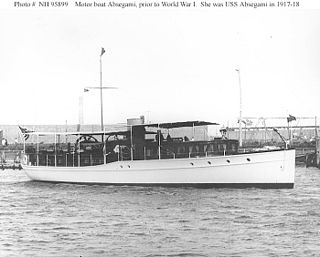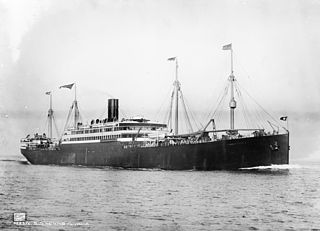
USS Absegami (SP-371) was a motorboat acquired on a free lease by the United States Navy during World War I. She was outfitted as an armed patrol craft and assigned to patrol the Delaware River from Philadelphia, Pennsylvania, to Cape May, New Jersey on the Delaware Bay. When the Navy found her excess to their needs, she was returned to her former owner.
USS Autauga (AK-160) was an Alamosa-class cargo ship commissioned by the US Navy for service in World War II. She was responsible for delivering troops, goods and equipment to locations in the war zone.

SS Pennsylvania was a transatlantic liner that was launched in Ireland in 1896 and spent most of her career with Hamburg America Line (HAPAG). She was the first of a class of four HAPAG sister ships that were built in the United Kingdom and Germany between 1896 and 1899.

Ophir was an Orient Steam Navigation Company steam ocean liner that was built in 1891 and scrapped in 1922. Her regular route was between London and Sydney via the Suez Canal, Colombo and Melbourne.
USS SC-255, sometimes styled as either Submarine Chaser No. 255 or S.C.-255, was an SC-1-class submarine chaser built for the United States Navy during World War I. Like most members of her class, she was not named and known only by her designation.
USS SC-277, sometimes styled as either Submarine Chaser No. 277 or S.C.-277, was an SC-1-class submarine chaser built for the United States Navy during World War I. Like most members of her class, she was not named and known only by her designation.

USS Maartensdijk was a cargo steamship that was laid down in England in 1902 as Egyptiana, but launched as Rapallo. She served in the United States Navy as USS Maartensdijk from 1918 until 1919, with the Naval Registry Identification Number ID-2497.

USS Zuiderdijk was a cargo ship that was built in England in 1912 as Sharistan, but was renamed Zuiderdijk later that year when she changed owners. She was USS Zuiderdijk with the Naval Registry Identification Number ID-2724, from 1918 until 1919. She was renamed Misty Law in 1923, Edera in 1931, Frin in 1956 and Mahfuz later in 1956.

SS Statendam was a transatlantic ocean liner that was launched in Ireland in 1898 for Holland America Line. She was the first of several ships in the company's history to be called Statendam. She was NASM's first ship of more than 10,000 GRT, and she was the largest ship in the company's fleet until Potsdam was completed in 1900.

USS Rondo (ID-2488) was a Dutch cargo steamship that was built for Stoomvaart Mattschappij Nederland in 1914. She served in the United States Navy from March 1918 until June 1919. She was scrapped in 1933.

USS Avenger (SP-2646) was an armed motorboat that served in the United States Navy as a patrol vessel in 1918.

USS Oosterdijk was a Holland America Line cargo steamship that was built in 1913 and sank as a result of a collision in 1918. She served in the United States Navy, with the Naval Registry Identification Number ID–2586, from March 1918 until her loss that July. Some sources anglicise her name as Oosterdyk, but Lloyd's Register registered her with the Dutch spelling Oosterdijk.
The first USS Hampton (ID-3049), also listed as SP-3049, was a United States Navy tug in commission from 1918 to 1919.

USS Katie (SP-660) is a civilian motor vessel which was commissioned into the United States Navy as a patrol vessel from 1917 to 1918.

USS Sea Rover (SP-1014), later AT-57, was a United States Navy armed tug in commission from 1918 to 1921.
USS Bellingham (ID-3552) was a United States Navy cargo ship in commission from 1918 to 1919. She later served the government of the Soviet Union as SS Nevastroi for many years.

HMS Ambrose was a steamship that was built for in 1903 as a passenger liner. The Booth Steam Ship Company ran her scheduled on services between Liverpool and Brazil until the First World War.
HMS Perth was a steamship that was built in Scotland in 1915, renamed Lafonia in 1946 and Valfiorita in 1950, and scrapped in Italy in 1962. She was designed as a coastal passenger and cargo liner, but was completed in the First World War as an armed boarding steamer for the Royal Navy. In the Second World War she was converted into an ocean boarding vessel, and served also as a convoy rescue ship.

SS Ophir was a Dutch steamship that was built in 1904. She carried passengers, cargo and mail between Rotterdam and the Dutch East Indies until March 1918, when the United States seized her under angary and she became USS Ophir (ID-2800). In November 1918 a fire and explosion damaged her beyond economic repair. She was scrapped in 1922.
SS Verona was a transatlantic ocean liner that was built in Ireland in 1908 for an Italian shipping line. She was a troop ship in the Italo-Turkish War of 1911–12 and in the First World War in 1917–18. In 1918 a German submarine sank her in the Mediterranean with great loss of life.















